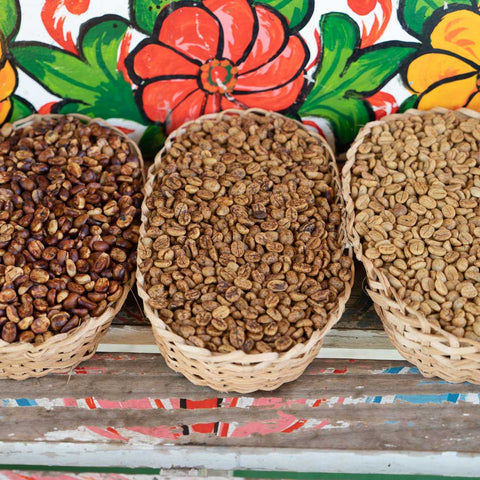What is Processing & Why Do I Care?
Different flavors are really the only reason I’m interested in processing. Different processing methods affect coffee in wild ways. There are 3 main processing methods, so I made a visual that should help.

WASHED:
Machines are frequently used to squish the cherry against a screen until the seed is forced through. The fruit is fully cleaned off the seed and the coffee is dried. The washed process is the fastest processing method and creates a lot of clarity in the finished coffee. The main drawback of washed processing is that it uses the most water of all the processing methods.
Flavor Effect: Clean mouthfeel and bright crisp flavors are what you get from washed coffees. The flavors tend to be more easy to distinguish, like the difference between a Granny Smith apple, an orange, or a peach.
PULPED NATURAL
Generally this starts out looking like a washed process, and then halfway through fruit removal, it shifts into being a natural process. There is a lot of fruit left on the seed, and the coffee is laid out on drying beds to dry with the fruit jelly all over it. It looks like honey, and in Costa Rica a common processing method is “Honey Process.” This is a slightly longer version of the standard pulped natural.
Flavor Effect: Nutty, syrupy or creamy body, citrus fruit, some chocolatey and fruity flavors. Honey process has these flavors with more of a stewed fruit heaviness with caramel or burnt sugar sweetness.
NATURAL
This process is so fascinating to me because it's so simple and yet difficult. It is the careful process of taking a cherry, making a cherry raisin, taking the seed out, and then you’re in flavortown.
Flavor Effect: Heavy, usually intense fruitiness, sometimes a winey or boozy fruit flavor, can be strong on nuttiness or chocolate, with a dense syrupy mouthfeel. A lot of Ethiopian coffees are naturally processed, and they are a category of their own: generally they are sweet and intensely berry, smooth and clean.

Honey process before drying

Honey after it's dried

Natural being dried

Washed being dried
There you have it! That's processing in a nutshell. There are more methods, but they are basically nuances that have grown out of these three base methods. We will get into some of these nuances soon (we may or may not have coffees of nuanced processing coming soon).
I’m betting that most of you are most excited by the pulped natural and natural methods. The cool thing is the flavor effects I listed are simply the things added by processing--that doesn't even account for the flavor already in the coffee! These combinations are what make coffee so exciting. It's also the reason that most of you are such fans of a certain seasonal coffee blend we sell between November and February… Milk & Cookies!! Milk and Cookies is a combination of two naturally processed coffees, one from Ethiopia and one from Brazil. I put a little extra pizzaz on the roast and the result is a wonderfully sweet, gooey fudge, creamy caramel, mulled spice flavor bonanza.
Who’s extra excited about Milk & Cookies now that you know where the good good comes from?!
~Coffee is amazing~
Levi Hartsfield // Roaster & Co-Founder
Photos from cafeimports.com
Love it! And the flow chart was a helpful visual before reading the blog.
This is so interesting…..to see and understand more about what you do and how the different flavors come about! You do a great job! ❤️
